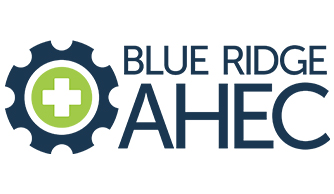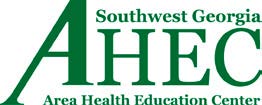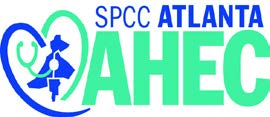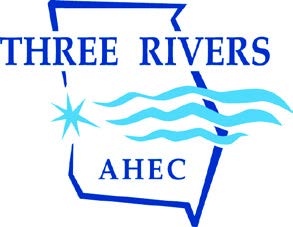FIRST PROGRAM OF ITS KIND IN THE U.S.
Preceptor Tax Incentive Program

Recruit
18,000 total participants in 511 regional AHEC activities and programs
Learn about recruitment efforts by AHEC
Train
Facilitated 3,327 total student rotations in clinical pursuits across Georgia
Learn about training efforts by AHEC
Retain
Partnered with 1,139 professionals to mentor graduating students
Learn about retentions efforts by AHEC- Augusta University
- AHEC
- PTIP
Preceptor Tax Incentive Program (PTIP)
In 2014, Georgia became the first state in the nation to offer a tax deduction to community based physicians who provided uncompensated training to our state’s medical students.
In 2019, the Georgia legislature took this a step further by abolishing the old tax deduction and replacing it with a tax credit applicable to an individual’s state income tax. The new program allows community based preceptors (licensed medical, osteopathic, advanced practice nurse, or physician assistant) who are not compensated for teaching, to earn tax credits for providing community based clinical training for students from the state’s public or private medical, osteopathic, advanced practice nursing, or physician assistant educational programs.
Physicians can earn a total of $8,500 tax credits each calendar year while APRNs and PAs can earn up to $6,375 in tax credits for the same period. Credits are accrued by providing a rotation (160 hours of training per credit) with a maximum of 10 possible credits earned. The first 3 rotations are rewarded with a $500 tax credit (for each rotation) for physicians; APRN and PA’s earn $375 each for the first 3 rotations completed. Physicians earn $1000 each for rotations 4-10 while APRNs and PAs earn $750 each for rotations 4-10.
This novel program provides a way for Georgia’s educational partners to say “thank you” to the volunteer, uncompensated community based preceptors who train our next generation of key health care providers.
A preceptor shall not be eligible to earn hours credited toward preceptorship training if he/she has not registered. The deadline is 12/31 to receive credit for the preceding year. See our brochure for details.
EligibilityFAQsPTIP Resources News and DeadlinesFlowchart of PTIP Process
Contact Us
Area Health Education Centers
Health Sciences Campus
AA-1057
1120 15th Street
706-721-8331
706-721-8508
Eligibility
The Preceptor Tax Incentive Program (PTIP) rewards licensed Georgia MD/DO, NP and PAs taking Georgia medical, physician assistant, and nurse practitioner students into their practices for the students' required clerkships.
Medical students from both allopathic and osteopathic schools are included. Preceptors who receive direct compensation for teaching from ANY source are not eligible to earn this deduction.
Preceptor Qualifications
- Licensed physician, nurse practitioner or physician assistant in Georgia
- Cannot receive direct compensation for teaching medical, osteopathic, NP, or PA students from any source
- The credit is only available for rotations supporting Georgia medical, osteopathic, NP, or PA programs
- Must complete a minimum of 1 rotation to be eligible; credit is provided retroactively once eligibility is established. A maximum of 10 rotations may be claimed each calendar year.
- Maximum tax credit earned each year is $8500
The 160 hours does NOT have to be tied to a single rotation, but is accrued across all students precepted. Some student rotations may be one day a week for four months, while others may be completed in 4-6 week blocks. Using hours to determine a credit levels the field so that all credits are earned based on 160 hours of teaching.
Incentive Structure
Physician Preceptors
- Rotations 1-3 earn $500 per rotation
- Rotations 4-10 earn $1000 per rotation
- Maximum credit available = $8,500
APRN or PA Preceptors
- Rotations 1-3 earn $375 per rotation
- Rotations 4-10 earn $750 per rotation
- Maximum credit available = $6,375
Eligible Programs
Programs will submit completed rotation dates and hours to the Statewide AHEC.
MD/DO
- Augusta University
- Emory University
- Mercer University
- Morehouse School of Medicine
- Philadelphia College of Osteopathic Medicine, Georgia Campus
PHYSICIAN ASSISTANT
- Augusta University
- Brenau University
- Emory University
- Mercer University
- Morehouse School of Medicine
- Philadelphia College of Osteopathic Medicine, Georgia Campus
- South College, Atlanta Campus
- Berry College
- South University
NURSE PRACTITIONER
- Albany State University
- Augusta University
- Brenau University
- Clayton State University
- Columbus State University
- Emory University
- Georgia College & State University
- Georgia Southern University
- Georgia Southwestern University
- Georgia State University
- Kennesaw University
- Mercer University
- Middle Georgia State University
- South University
- University of North Georgia
- Valdosta State University
Training for Preceptors and Programs
New training materials coming soon!
Preceptors
If you do not receive a confirmation, your registration may not have been submitted, and you will need to repeat the process!
Currently, the registration system does not work with Internet Explorer. Chrome or Firefox can be used as alternative browsers until further notice.
Please email ptip@augusta.edu with any questions.
Programs
A new system has been developed for programs to submit rotation data. The new system allows programs limited access to enter rotation information directly into the PTIP data system.
If your program has not been granted access to submit data, contact the PTIP office at 706-721-8331 or ptip@augusta.edu.
Spring Deadline
- June 1
Program data submission deadline
Fall Deadline
- September 1
Program data submission deadline
Winter Deadline
- December 15
Program data submission deadline
Preceptors PTIP FAQs
Who is eligible for the tax incentive?
A licensed Georgia Physician (MD or DO), Advanced Practice Nurse (APRN), or Physician Assistant (PA) providing uncompensated community based training for medical, nurse practitioner or physician assistant students matriculating at a Georgia program (public or private) for clinical rotations
How many tax credits can I earn?
Credits are available for up to 10 rotations (160 hours each rotation). There is an incentive structure built into the program to encourage you to precept the maximum number of rotations allowed under this legislation. Physicians can earn a maximum of $8,500 in credits; APRN and PAs can earn a maximum of $6,375 in credits. These are earned as follows:
Physicians:
- Rotations 1-3= $500 each rotation
- Rotations 4-10= $1,000 each rotation
APRN/ PAs:
- Rotations 1-3= $375 each rotation
- Rotations 4-10= $750 each rotation
Why are Physicians provided a higher level of credit than the APRN or PA preceptors?
This is based solely on the income differential among the professions.
How will preceptors register for the program? do I need to re-register each year?
Use the Preceptor Registration form on this site. You only need to register once; however if any of your contact information changes you will need to go into the system and edit your record. It is the responsibility of the preceptor to maintain current information in the registration system.
A preceptor shall not be eligible to earn hours credited toward preceptorship training if he/she has not registered. The deadline is 12/31 to receive credit for the preceding year.
I have not precepted students before; how do I get started?
Please contact our office or your regional AHEC to indicate your interest in precepting students. We can put you into contact with academic programs seeking clinical preceptors. There is also a button on our website you can click to indicate your interest in precepting more students.
How will student hours be counted?
A rotations is defined as 160 hours of community based clinical training. It can be accrued from multiple programs, and hours do not have to occur within one student rotation. Academic programs submit information certifying that student rotations with a preceptor have been completed; preceptors do not submit rotation data.
What type of documentation will I receive for my tax purposes?
Tax credit Certification letters will be issued by the Statewide AHEC Program Office by January 30 of each year for the last full calendar year. No other entity is legislatively authorized to produce these letters.
Can I carry over rotations into the next calendar year for eligibility?
No, all credits must be used in the year earned. EXAMPLE: If your state tax debt was $4,000 but you had earned $5000 in credits, you would not be able to “carry over” the unused credit of $1,000 to tax year 2020. You may not transfer unused credit to another individual, nor can you “cash out” unused credits.
If my partner(s) precept part of the time but I do the majority of the supervision, must I divide the earned deduction with them?
You can choose from several options: 1) claim the rotation fully; 2) alternate claiming rotations with your partner; 3) each of you claim a percentage of the hours earned. However the student’s academic program must be notified to list your contribution in one of these ways, prior to submission.
If my practice receives financial support from a program, does that disqualify me from claiming the credit?
Only if you *personally* receive direct compensation from a program would you be disqualified. If you receive payment to teach students from ANY source, you are not eligible to earn the tax credits. If your practice receives an administrative stipend to assist with administrative costs of precepting then you are not disqualified.
If a student only needs 80 hours (as do some NPs for a particular experience), will that count as a full rotation if I precepted them the entire time?
The legislation defines an eligible rotation as 160 hours. For this example, the preceptor would need to provide two rotations that would total 160 hours to qualify for one credit.
If I precept two medical students simultaneously, do both rotations count?
Yes, each individual student rotation will be counted.
How do you determine who gets the tax credit?
Each Georgia medial, osteopathic, nurse practitioner and physician assistant program is responsible for submitting all community based preceptor hours to the Statewide AHEC Network Program Office. The Office will match the hours to registered preceptors and credit hours provided.
I received my Certification Letter for the calendar year, but the credit amount is incorrect. Who should I contact for this?
Preceptors need to discuss any discrepancies with the Academic Program that sends them students to precept. The PTIP office does not have any knowledge of where students are placed and who they are placed with and does not certify the rotations occurred. It is imperative that you communicate clearly with the programs with which you work to insure you are credited with the appropriate hours you provide.
Program PTIP FAQs
Will programs be required to report students' personal information?
Data required for students include: first name, last name, type of rotation (MD/DO/APRN/PA), date rotation completed, and number of hours of the rotation certified.
How do I report completed rotations by our students?
Programs are issued a secure log-in ID and password to submit rotation data directly into the PTIP system.
Can educational institutions register their preceptors?
We encourage preceptors to register themselves rather than asking a program to do so for them. However programs are encouraged to inform their preceptors of this opportunity and to share the registration link with them. We want preceptors to connect this benefit with the academic programs with whom they partner.
Tax Preparers PTIP FAQs
What documentation will be provided for tax purposes?
Department of Revenue language will be included in the yearly Tax Manuals for Georgia. Tax Credit Certification letters will be issued by the Statewide AHEC Network Program Office by January 31 of each year for the last full calendar year.
Does the credit count under the preceptor's Social Security Number or the practice tax ID number?
The credit applies *only* to the preceptor's Social Security number.
Is there a line item designated for the credit on tax forms?
Yes. The IND-CR 212 is included in the 2020 form 500 and can be located at: https://dor.georgia.gov/500-individual-income-tax-return





